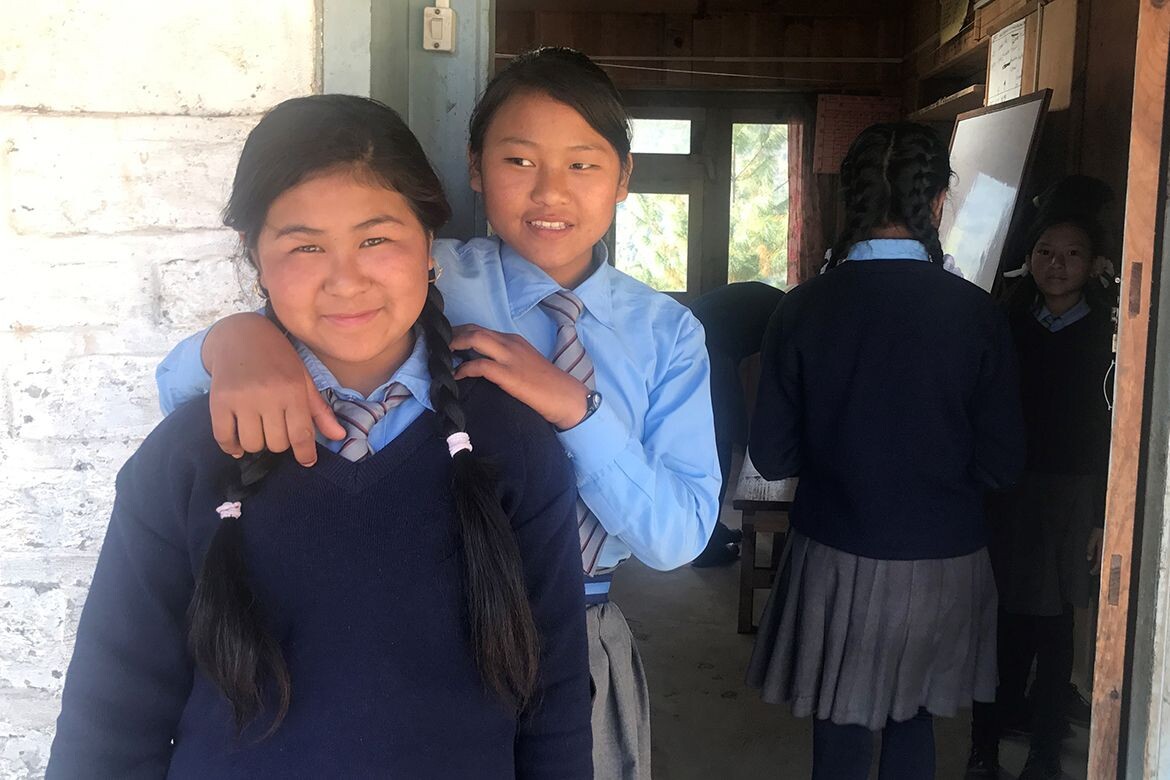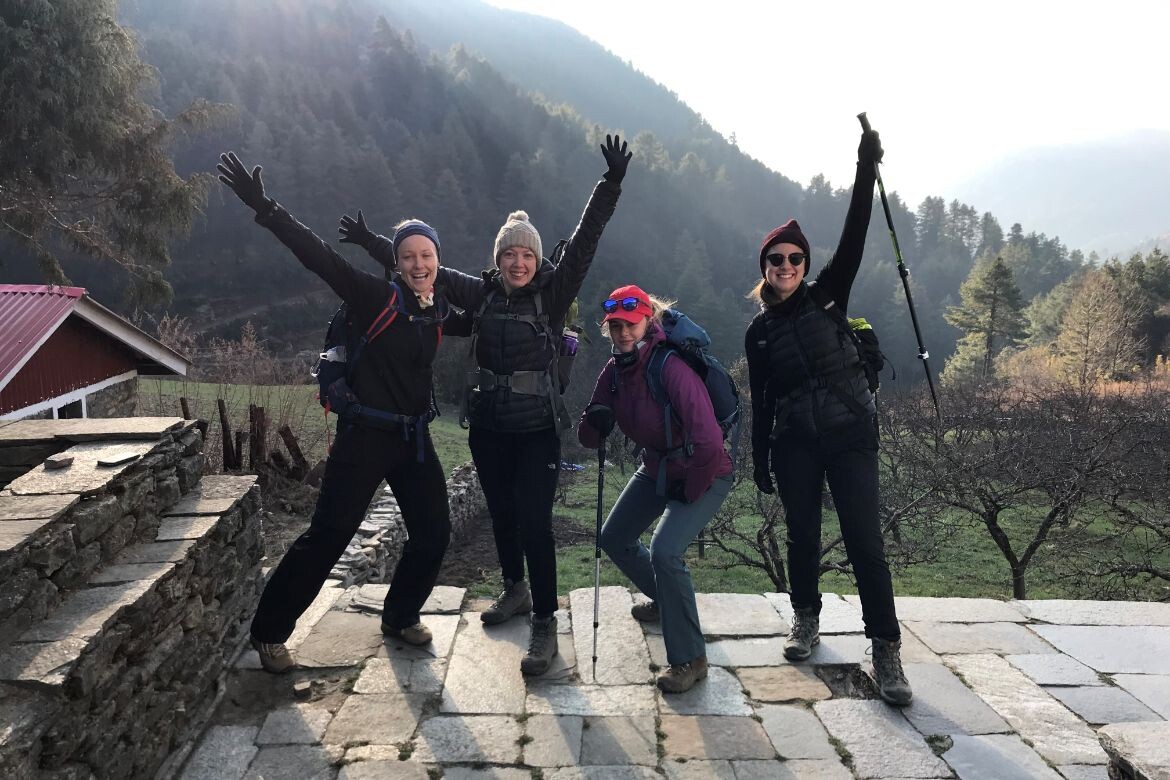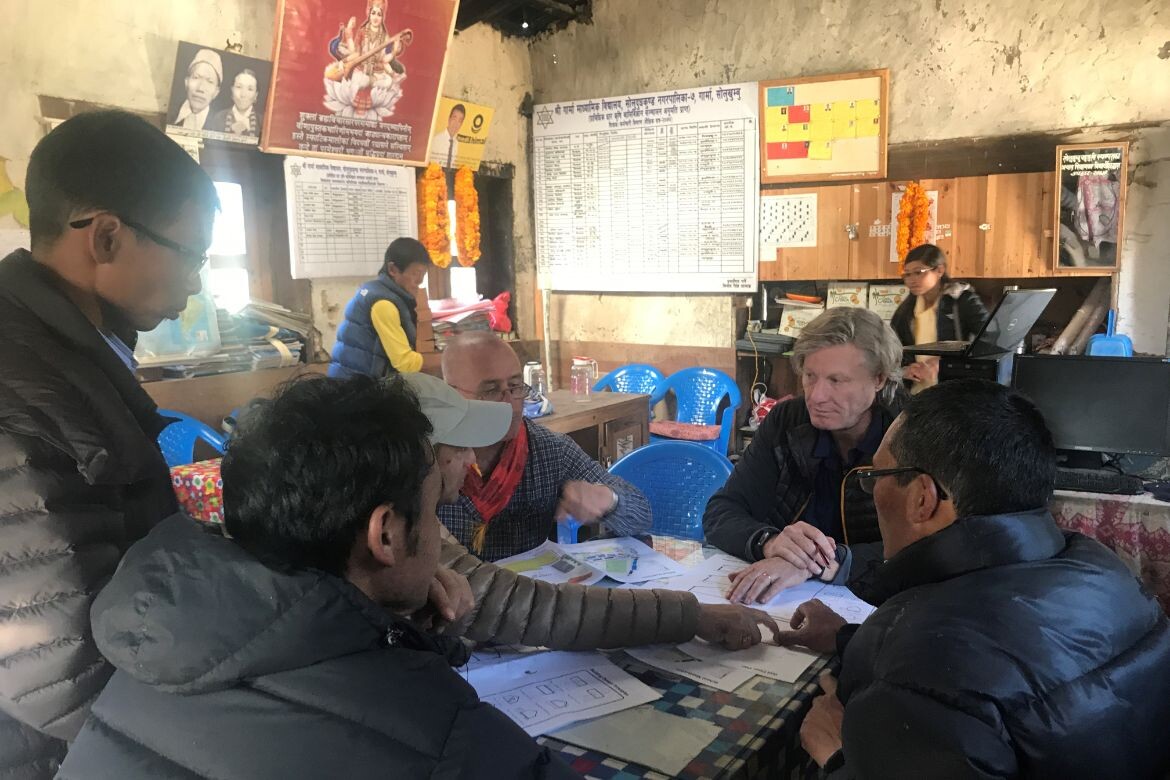Since the Nepal earthquakes of 2015, architect Neill Johanson of Davenport Campbell has been working to rebuild schools and support communities in Nepal’s remote regions. It’s a pro-bono project that has expanded from emergency efforts to a wider and longer-lasting vision.

Students at Garma, in Nepal.
August 7th, 2023
When architect Neill Johanson headed to Nepal to guide an expedition to Everest Base Camp in 2015, little did he know that it would change the trajectory of both his life and life’s work for years to come. The Nepal earthquakes of 2015 took place as Johanson and the trekking group (for which he was a guide), made their return journey from Everest Base Camp.
The reality of the earthquake was terrifying. “Buildings were falling apart around us, car-size boulders were rolling down the mountains, and giant parts of the track were disappearing before our very eyes,” he recalls.

The country had just eight helicopters to rescue people in distress and Johanson and his group were lucky enough to be airlifted out by a helicopter assigned to rescuing people from various parts of the track.
Deeply affected and inexorably drawn together by the experience, Johanson and his personal and professional network turned quickly to the discussion of how they could help to reconstruct a country that was severely impacted by this natural disaster.
Johanson, who is a principal at Davenport Campbell, fulfilled a natural calling in this cause, putting his expertise and practical skills towards rebuilding education facilities in remote regions of Nepal.
The building of Garma School and Community Hall


NAWIC expedition to Nepal.
The first project he undertook was the Garma School and Community Hall in the Solukhumbu District located close to Mount Everest. In partnership with the Australian Himalayan Foundation (AHF), and REED Nepal (a local non-government agency committed to quality education and resilient environments), and Australia’s own National Association of Women in Construction (NAWIC).
The pro-bono project team saw Davenport Campbell assume the role of master planner and site supervision with its project team travelling to Nepal to work directly with the local community. Hassell developed an earthquake-proof classroom module; TTW provided engineering and construction expertise; and Tom Singleton acted as project manager.


Classroom module under construction.
The purpose? “To provide immediate aid by reconstructing schools destroyed by the earthquake, to create safe havens in case of earthquake and get children back into school and learning,” says Johanson who speaks of the critical importance of lifting girls and women out of poverty, contributing to reduce child marriage and improve health outcomes.
“When we got to the end of the Garma School program, we sat with the school’s teachers and headmaster and said, ‘What do we need now?’” The answer was, a community hall.
Johanson went on to raise AUD$100,000 and designed and constructed the hall, with support from many of the builders and suppliers they work with daily. “NAWIC in particular was strongly supportive of the program, reflecting their commitment to elevating women out of poverty through education,” says Johanson.


Community Hall opening ceremony.
While the onset of COVID-19 and international lockdowns prevented the project team from having more active involvement in the AHF project work initially, they have now resumed the program, this time in far West Nepal with the Durga Mahalingha Secondary School, in Shauka.
This project, while not impacted by the earthquake, will build upon the work undertaken in Garma and other remote communities with the AHF as part of a wider program in West Nepal to raise education and health outcomes. It will help isolated communities gain access to basic necessities, like education and health facilities and teaching support, and ensure children can receive the best possible educational opportunities and health services.


Imagery of students and classroom conditions at Durga Mahalingha, in West Nepal.
According to the Nepal Education Sector Analysis 2021, school dropout and repetition rates are quite high in early grades and grade eight. Basic and secondary education survival rates, as well as grade 10 exam scores, are low. Many students do not make the transition from basic to secondary education (Grade 8 to Grade 9). While the survival rate to Grade 8 stands at nearly 80 per cent, the survival rate to Grade 10 is only about 60 per cent. Even fewer students transition to higher secondary (Grade 11 and 12) with the survival rate from Grade 10 Grade 12 reaching only 24 per cent.
The report, entitled School Education Sector Plan (2022 to 2032), cites low enrolment as a concern at secondary education level, especially at grades 11 and 12, with many students unable to complete their studies and progress to higher levels of education. Nepal Living Standards Survey data also shows a strong correlation between households’ economic status and participation in secondary school and grade 11 and 12 level. Many children are forced to help with household and family farm work. The Nepal Education Sector Analysis 2021 states that boys tend to leave school under social and household pressure to join the labour force and girls are likely to drop out due to early marriage and childbearing.

Nepal’s early marriage rates are one of the highest in the region – 18 per cent of women aged 20-49 years old have married before the age of 15, while 48.5 per cent of women in that same age bracket married before the age of 18. Moreover, early childbearing is relatively common, with about one in six (13.8 per cent) women aged 20–24 years having had a live birth before the age of 18. (NMICS 2019.)
“We place a particular focus on the education and training of women and girls, because they are often the first to be left behind,” states Johanson, drawing attention to the following report insights: in Nepal, married girls are 11 times more likely to be out of school compared to their unmarried peers and early marriage is cited as the second most common reason for school drop-out for girls aged 15-17 and the most common reason for school drop-out for women in the age range 20-24 years.
As well as fundraising, Johanson through sheer force of energy and passionate commitment formed a Donor Circle. The Donor Circle consists of 12 of Davenport Campbell’s closest suppliers who simply asked, ‘What can we do to help you make it happen?’.”
Together the donor circle gifted AUD$60,000 to the AHF to support the Sambridhi Pashim Nepal (Prosper West Nepal) school rebuilding program. This involves 38 schools in West Nepal which are undergoing basic works to improve the quality of their classrooms.

Already an engineer has been appointed to oversee the school rebuilding program, with basic works targeting everything from flooring, fencing, windows, doors, toilets and safety rails to child-friendly furniture, water supply for drinking water, science labs, libraries, and solar power for lighting. Works will begin at the end of the monsoon season.
“If we can build these great places and collaborate with people in our industry, if we can raise funds to specifically support teacher programs, we’re attacking this from all kinds of different fronts. And, from an architectural viewpoint, we’re creating sustainable buildings that ensure that what we do builds in our own redundancy,” comments Johanson.
The long-term vision of Johanson’s work is to transfer planning, design and construction skills into Nepal’s local non-governmental agencies, hand over the building plans at their earliest stages to local architects and engineers, and use locally sourced materials to execute the projects. It’s a far cry from eight years ago where their support was reactionary and involvement comprehensively integrated through every stage to 2023, where “hopefully we do ourselves all out of a job”.
What started as a guiding trip in 2015, fed by Johanson’s strong sense of connection with Nepal – “I’d climbed Mount Everest and a series of other mountains over there, and I was connected to the Sherpa community” – has grown into a lasting relationship between a passionate community of Australian businesses and individuals, and local communities that are committed to building a stronger educational future for their people. “I was looking to repay the generosity of spirit in some way,” says Johanson, who continues to lobby for the education of children in Nepal, particularly for young girls and women.
“If you’d like to be involved, let us know, because the more we raise, the faster we can elevate children, and young women especially, out of poverty and contribute to ending child marriage,” says Johanson.
He gives special thanks to the members of the Donor Circle:
We think you might like this article about the shortlisted projects for The Influencer at INDE.Awards 2023.
INDESIGN is on instagram
Follow @indesignlive
A searchable and comprehensive guide for specifying leading products and their suppliers
Keep up to date with the latest and greatest from our industry BFF's!

Welcomed to the Australian design scene in 2024, Kokuyo is set to redefine collaboration, bringing its unique blend of colour and function to individuals and corporations, designed to be used Any Way!

A longstanding partnership turns a historic city into a hub for emerging talent

For Aidan Mawhinney, the secret ingredient to Living Edge’s success “comes down to people, product and place.” As the brand celebrates a significant 25-year milestone, it’s that commitment to authentic, sustainable design – and the people behind it all – that continues to anchor its legacy.

Stylecraft and NGV call for furniture and lighting designs addressing small-space living, with $20,000 prize and commercial development opportunity.

Pier Pavilion by Besley & Spresser provides a refreshing, architecturally thoughtful and versatile public space by the water at Barangaroo.
The internet never sleeps! Here's the stuff you might have missed

Carr’s largest residential project to date integrates concrete, steel mesh and landscape across 122 apartments in Melbourne’s Brunswick.

Sydney Open invites the public to explore over 55 buildings, spaces and new additions to the skyline, with a newly released Talks & Tours program offering direct access to the architects behind Bundarra and Pier Pavilion.

Phillip Withers joins the podcast to discuss landscape design in relation to Country, place and European notions of control, as well as his part on the Habitus House of the Year 2025 Jury.